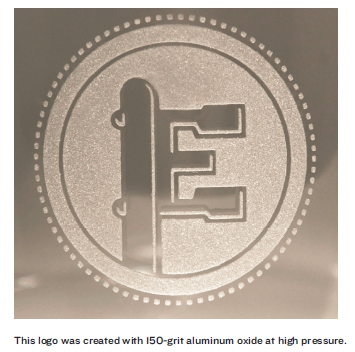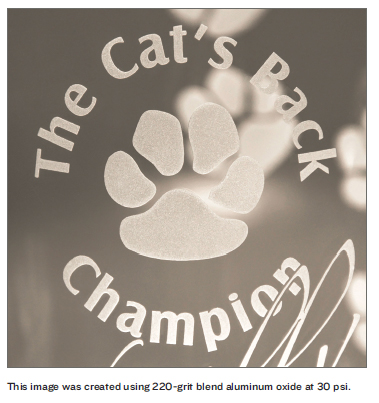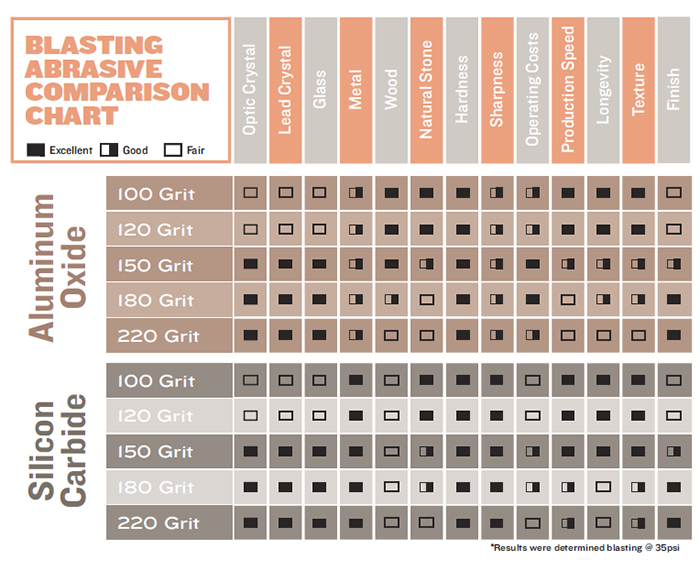Sandcarving is a great method for engraving products. Many businesses, including ARA member companies, use sandcarving in large and small production settings. Business owners or production managers usually have their preferences when it comes to abrasive and grit size. There are two abrasives commonly used for sandcarving: silicon carbide and aluminum oxide. Both are available in a range of grit sizes.
True Grit
Which Abrasive Is Right for Your Sandcarving Projects?
Liz Haas, Rayzist Photomask, Inc.
(Originally published in the November 2014 issue of Recognition Review.)
Sandcarving is a great method for engraving products. Many businesses, including ARA member companies, use sandcarving in large and small production settings. Business owners or production managers usually have their preferences when it comes to abrasive and grit size. There are two abrasives commonly used for sandcarving: silicon carbide and aluminum oxide. Both are available in a range of grit sizes.
Factors that affect which abrasive and grit size you will use include:
- The mil thickness of the photoresist film you use. Contact your photoresist film manufacture for abrasive recommendations based on the material’s thickness.
- Your business’s production demands. The businesses I visit vary widely in how many products they blast each day—from a few items a day to hundreds.
- The substrates you’ll blast. If you’re just starting out, consider the products you plan to offer and know the limitations of the abrasive you begin using. If you accept a job that can’t easily be done with that abrasive, you may need to purchase another option.
- The type of finish you want on your products.
 Though silica sand is used in industrial sandblasting, never use it as a sandcarving abrasive. Silica sand’s small particles are dangerous to your health. Silcon carbide and aluminum oxide are safe for use.
Though silica sand is used in industrial sandblasting, never use it as a sandcarving abrasive. Silica sand’s small particles are dangerous to your health. Silcon carbide and aluminum oxide are safe for use.
Each sandcarver has his or her reasons for choosing a certain abrasive or a particular grit size. Some will use a finer grain and blast at a higher pressure; others will use a coarser grain and blast at a lower pressure. Both methods will etch the substrate, but each method will give a slightly different texture or feel to the surface. This is especially noticeable in fine glass, lead crystal, optic crystal, and artwork with a large negative etched area. A coarser grain gives the etched surface a textured look. A finer grain gives the etched surface a smooth, silky texture.
There are options that will suit most carvers, but no one-size-fits-all for every person and every product. You need to personalize your abrasive just like you personalize the products you create.
Abrasive Media
When the same grain size and blasting pressure are used, silicon carbide and aluminum oxide give the same etched look, in my opinion. Why use one over the other? Silicon carbide will etch more quickly than aluminum oxide because of the sharp angular shape of the media. Faster is better, right? Not always. Some high production facilities prefer the etching speed of silicon carbide to decrease production time per piece though silicon carbide generally costs more and incurs higher operating costs. When time is money, these price differences may not matter to you.
 One of the problems with grit size is that it changes as the medium is used. Each abrasive breaks down during blasting causing the grit to become finer and finer after several recycles. After a few uses, that 120 grit you put in your sandcarving system becomes a 150, then 180, and eventually, even finer. Silicon carbide will stay sharp as it breaks down, but aluminum oxide will dull.
One of the problems with grit size is that it changes as the medium is used. Each abrasive breaks down during blasting causing the grit to become finer and finer after several recycles. After a few uses, that 120 grit you put in your sandcarving system becomes a 150, then 180, and eventually, even finer. Silicon carbide will stay sharp as it breaks down, but aluminum oxide will dull.
With a hardness rating of 9.25 on the Mohs scale, silicon carbide isn’t harder than aluminum oxide and sharper, resulting in a quicker etch. Each grain is sharp, yet brittle, which causes the media to break and fracture more quickly during blasting. Wear parts such as nozzles and blast hoses wear out more quickly due to the sharp, aggressive grain. Though silicon carbide’s sharpness lasts longer than aluminum oxide’s, it becomes smaller/finer more quickly. This results in the recycled silicon carbide being removed by the sandblasting system’s separator/reclaimer (dust collector) and reducing the abrasive volume. In short, you may go through silicon carbide more quickly.
Silicon carbide is highly reflective, creating a sand stream that is easily seen during blasting, even in low-level lighting. Another benefit of silicon carbide is that it reduces incidences of static shock, which can occur when blasting metal and lead crystal in certain weather conditions.
In my opinion, the only real, noticeable difference between aluminum oxide and silicon carbide is on metals; silicon carbide provides a polished effect and appears to leave a brighter finish while aluminum oxide leaves a slightly dull finish.
Aluminum oxide isn’t as hard as silicon oxide, rating 9 on the Mohs scale of hardness. Aluminum oxide and silicon carbide have the same density ratings. Aluminum oxide is easier on your wear parts, such as nozzles and blast hoses, due in part to the blocky shape of its grains. Aluminum oxide is generally used as a multipurpose abrasive because of its durability and cost effectiveness. Aluminum oxide contains a level of iron in the product, which can increase the possibility of shock while blasting leaded crystal and metal. It is usually more affordable than silicon carbide. Some engravers experience skin sensitivity to aluminum oxide and therefore prefer silicon carbide.
Blast abrasives are available from many suppliers in different qualities/grades and grain tolerances. Certain grades can be very powdery because of a lower tolerance or a blended grain. Rayzist recommends virgin grain or a military grade specification as the best abrasives. Both are usually manufactured in the United States.
Grit Size
 There are several grit sizes available. Standard 150 grit is ideal for a wide range of materials including glass, optic crystal, metal, and natural stone. With 150 grit, you can etch detailed designs or bold patterns into all surfaces.
There are several grit sizes available. Standard 150 grit is ideal for a wide range of materials including glass, optic crystal, metal, and natural stone. With 150 grit, you can etch detailed designs or bold patterns into all surfaces.
Coarser abrasive sizes such as 100 grit or 120 grit are recommended for harder surfaces—such as granite, pavers, bricks, and concrete—because they will etch these hard surfaces more quickly, speeding up production. A coarser grit also will last longer on these surfaces than a standard size grit would.
Finer abrasive sizes, such 220 grit or 180 grit, are ideal for creating detailed artwork or achieving a certain etch texture. Sandcarvers use a fine grit if they consistently have extremely detailed artwork such as half-tone images, small images, or small fonts. The fine grain gets into the small open areas of the artwork to etch them.
When blasting glass or crystal, a fine grit will provide a polished, smooth finish but will also increase blasting time vs. using a coarser grit. In Europe, sandcarvers often use a 220 grit blend aluminum oxide. The etch is smooth—the surface has almost a silky feel—but the blasting time for each piece is greater. The smooth, silky finish is Europe’s standard for sandcarved items.
Before you choose an abrasive grit size, determine what items you plan to sandcarve. Will you offer a wide range of products, including natural stone, metal, glass, and optic crystal? Then 150 or 180 grit will function well. Will your business focus on natural stone projects? A more economical 100 or 120 grit will fit your needs.

Ask Yourself
The decision of which abrasive type and size to use really is based on what you are comfortable using and what provides the results you hold as your standard. Will you blast hundreds of pieces per day, making production demand a factor? Silicon carbide may be the right abrasive for you. Is operating cost what really matters to your business? Aluminum oxide might be the right choice. Do you want a texture or a smooth finish on your piece? These are all questions you must ask yourself when choosing an abrasive.
Liz Haas is a sales representative at Rayzist Photomask, Inc., a leading manufacturer of photoresist films and sandcarving equipment. Visit
www.rayzist.com for more information on Rayzist and sandcarving or to shop in Rayzist's online store.